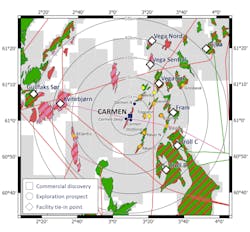Wellesley discovers hydrocarbons at Carmen prospect northwest of Troll
Wellesley Petroleum AS discovered commercial hydrocarbons at the Carmen prospect about 25 km northwest of Troll field and 150 km northwest of Bergen in Norwegian North Sea production license (PL) 1148. Carmen, Wellesley’s first operated HPHT well, is the operator’s sixth commercial discovery in the Troll area, the company said in a release July 19.
The operator estimates that the drilling campaign (exploration well 35/10-10 S and appraisal sidetrack well 35/10-10 A) has proved a developable gas-condensate accumulation of 60-100 MMboe. The licensees will initiate early-phase development studies and are considering additional appraisal wells. Development planning is expected to align with schedules of other developments in the area, including Toppand (Wellesley 5%), Swisher (30%), Grosbeak (5%) and Atlantis, the company said.
Information from the 35/10-A appraisal well also indicates the possibility for significant upside volumes, with up to 300 MMboe potentially being recoverable in and around the accumulation, subject to successful exploration and appraisal activity, the operator said.
The primary exploration target for well 35/10-10 S was to prove petroleum in Middle Jurassic reservoir rocks in the Etive and Oseberg formations in the Brent Group, and the secondary exploration target was to prove petroleum in the Early Jurassic Cook formation.
The well was drilled to a vertical depth of 4,030 m subsea. It was terminated in the Amundsen formation in the Early Jurassic. It encountered a 210 m gas-condensate column in the Ness, Etive, and Oseberg formations, 90 m of which is in sandstone layers with poor to good permeability. A 70 m gas-condensate column was encountered in the Cook formation, 23 m of which is sandstone with poor permeability. A 13 m light oil column was also found in sandstones in the Early Jurassic Amundsen formation. No formation water was encountered in the well. Extensive data acquisition and sampling have been carried out.
The objective of appraisal well 35/10-10 A was to encounter the petroleum-water contact in a lower position on the structure, and to collect liquid samples from the aquifer. The well was drilled down-dip 900 m west of the main bore to a vertical depth of 4,212 m subsea. It was terminated in the Cook formation in the Early Jurassic. It encountered a 240 m gas and volatile oil column in Ness, Etive, Oseberg, and Cook formations, 50 m of which is in sandstone layers with generally poor permeability. The well also encountered water-filled sandstone of good reservoir quality in the Cook formation. A gas-water contact was not encountered in the well.
The wells have been permanently plugged.
The wells were drilled by the Deepsea Yantai drilling rig, which will now drill wildcat well 25/7-11 S in North Sea production license 984, where DNO Norge AS is operator.
Wellesley is operator at PL1148 (50%) with partners DNO Norge AS (30%), Equinor Energy AS (10%), and AkerBP ASA(10%).
About the Author
Alex Procyk
Upstream Editor
Alex Procyk is Upstream Editor at Oil & Gas Journal. He has also served as a principal technical professional at Halliburton and as a completion engineer at ConocoPhillips. He holds a BS in chemistry (1987) from Kent State University and a PhD in chemistry (1992) from Carnegie Mellon University. He is a member of the Society of Petroleum Engineers (SPE).

